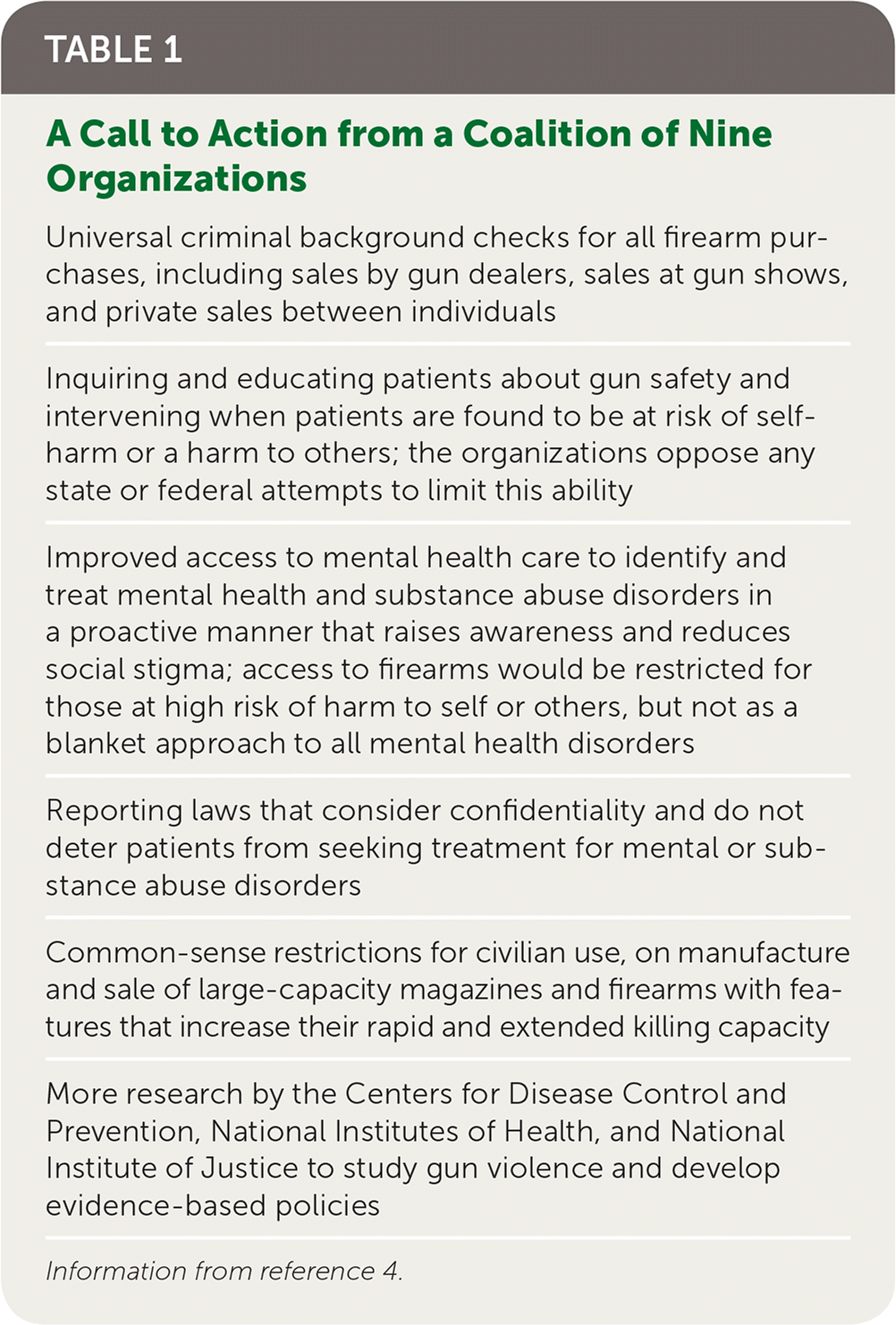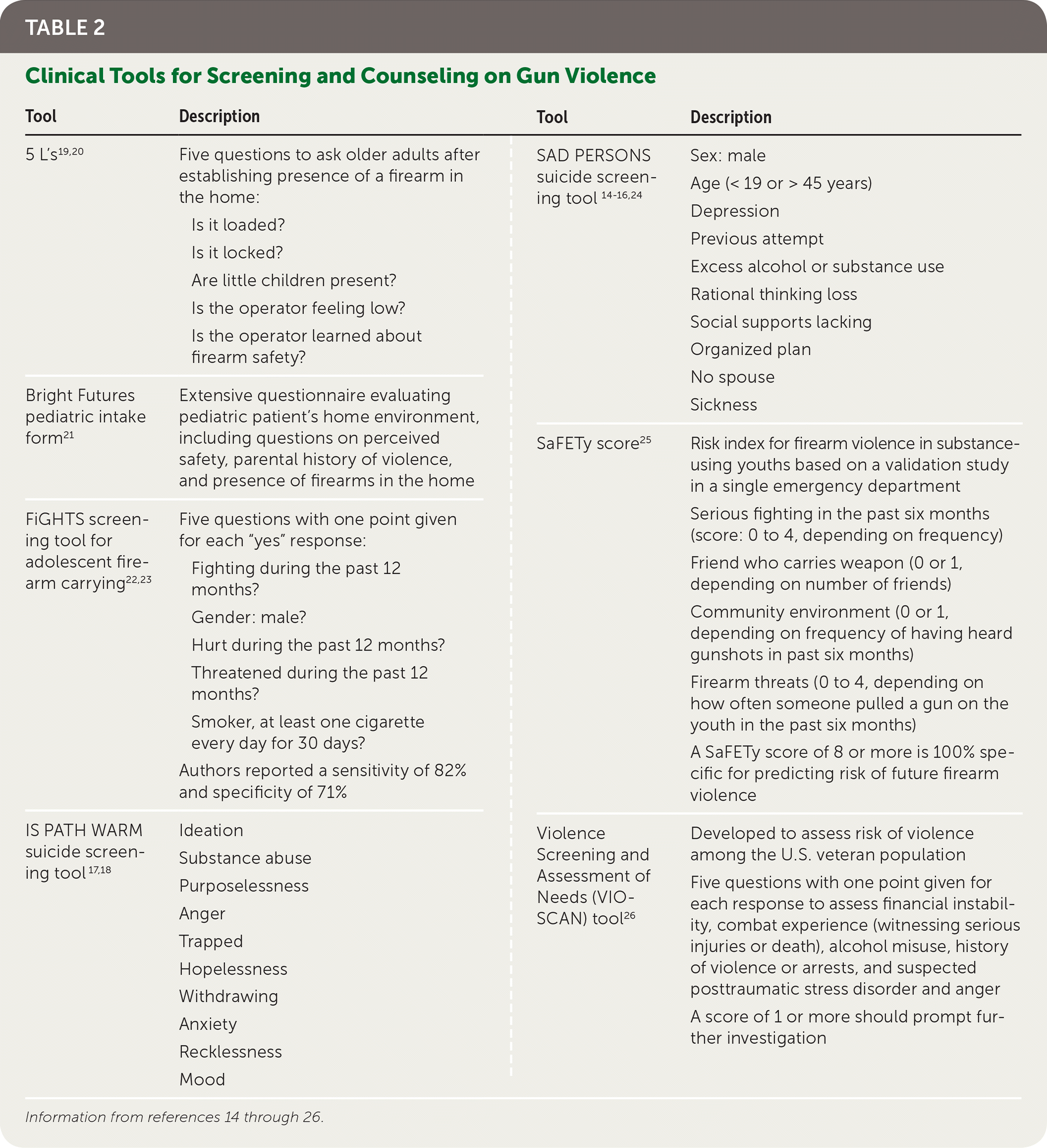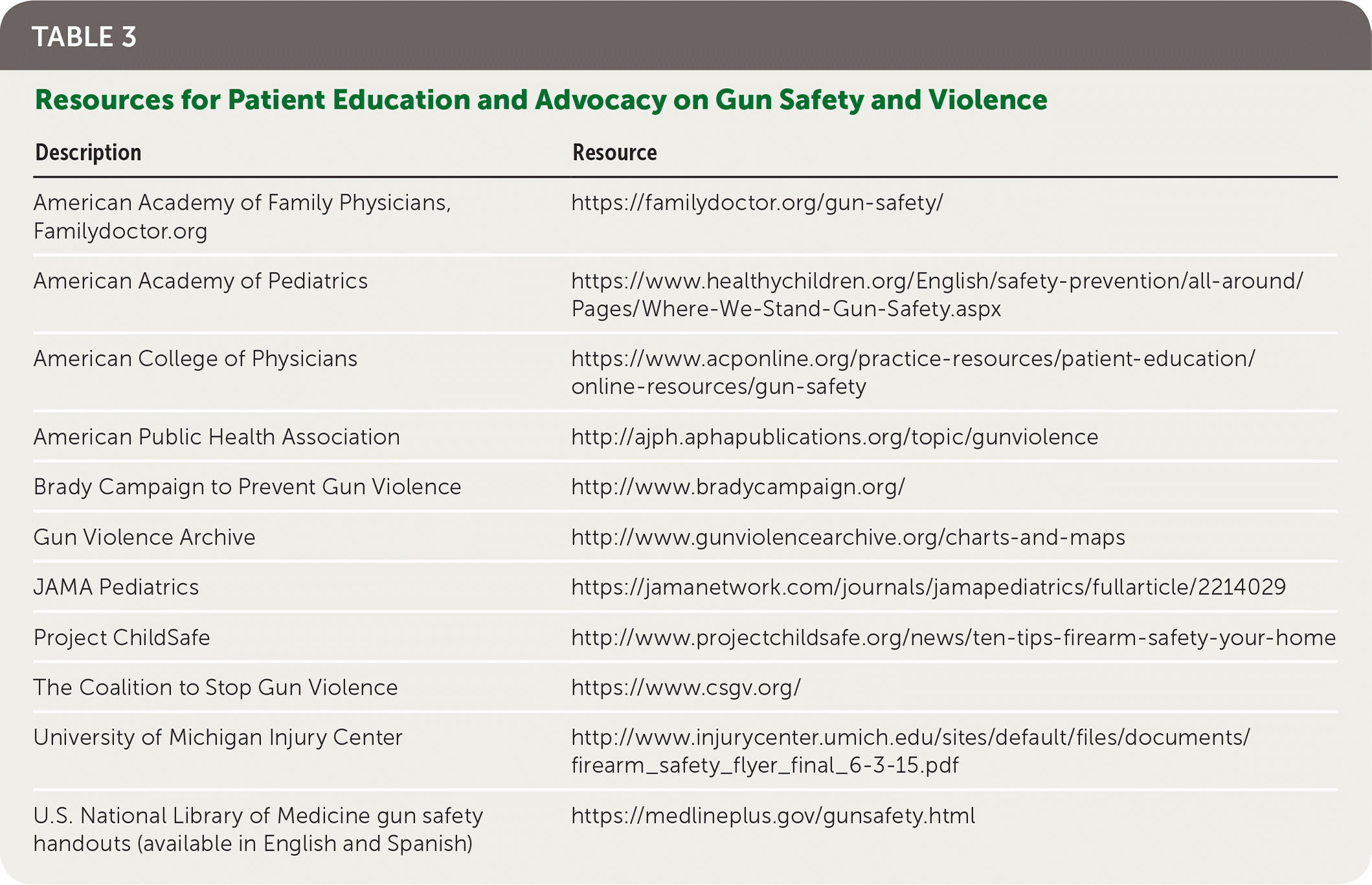
Am Fam Physician. 2018;98(9):560-568
Published online ahead of print on July 12, 2018
Author disclosure: No relevant financial affiliations.
“In the increasingly fragmented world of health care, one thing remains constant: family physicians are dedicated to treating the whole person.”1 Just as we care for the whole person in epidemics of influenza, obesity, opioid use disorder, heart disease, and human immunodeficiency virus infection to protect our patients' health, we must confront the epidemic of violence by persons using guns.
Recently, the American Academy of Family Physicians (AAFP) developed a position paper encouraging a public health approach to preventing gun violence (available at https://www.aafp.org/about/policies/all/gun-violence.html).2 The AAFP joined four other medical organizations in calling on national leaders to recognize violence by persons using guns as a public health threat and to fund necessary research to inform an evidence-based approach to this crisis.3 Table 1 outlines specific recommendations that the AAFP endorsed in 2015.4

| Universal criminal background checks for all firearm purchases, including sales by gun dealers, sales at gun shows, and private sales between individuals |
| Inquiring and educating patients about gun safety and intervening when patients are found to be at risk of self-harm or a harm to others; the organizations oppose any state or federal attempts to limit this ability |
| Improved access to mental health care to identify and treat mental health and substance abuse disorders in a proactive manner that raises awareness and reduces social stigma; access to firearms would be restricted for those at high risk of harm to self or others, but not as a blanket approach to all mental health disorders |
| Reporting laws that consider confidentiality and do not deter patients from seeking treatment for mental or substance abuse disorders |
| Common-sense restrictions for civilian use, on manufacture and sale of large-capacity magazines and firearms with features that increase their rapid and extended killing capacity |
| More research by the Centers for Disease Control and Prevention, National Institutes of Health, and National Institute of Justice to study gun violence and develop evidence-based policies |
Although medical organizations uniting to address a public health problem is important, where does that leave the family physician in practice? It may seem overwhelming to add yet another task to accomplish during a patient visit, especially if evidence is limited. The goal of this editorial is to provide the evidence supporting the strategies to prevent gun violence nationally and internationally, and to share tools for physicians to use in caring for their patients and communities.
Does Regulating Firearms Improve Safety and Reduce Violence?
The number of daily gun homicides is far higher in the United States than in other Western countries with highly developed economies (roughly 27 per day vs. less than five per day for other countries, adjusted for population size).5 A number of systematic reviews have examined the effects of various firearm regulations on the rates of gun-related violence. In 2005, a review by the Community Preventive Services Task Force concluded that there was insufficient evidence to determine the effectiveness of any laws, alone or in combination, on the rates of gun-related violence.6 A 2017 systematic review that used similar methodology to that of the Community Preventive Services Task Force identified 34 studies evaluating the effects of firearm laws on firearm-related homicides.7 The authors concluded that national and state laws mandating background checks and requiring a permit to purchase a firearm were associated with decreased firearm-related homicides. Four studies found that banning military-style assault weapons did not significantly decrease firearm homicides. Studies of laws limiting firearm sales and restricting firearms in public places had mixed results.
A 2016 systematic review of 130 studies conducted in 10 countries found that laws restricting the purchase of and access to firearms were associated with lower rates of intimate partner homicides and unintentional firearm deaths in children.8 Another review of studies that examined the rates of firearm availability by country, state, and locality found that increased rates of availability are associated with increased rates of homicide.9
A 2018 RAND review of U.S. studies on gun policy published since 2003 concluded that child-access prevention laws (e.g., safe gun storage) reduce self-inflicted and unintentional firearm deaths and nonfatal injuries among youth, and may reduce unintentional firearm injuries among adults.10 The review also found moderate evidence that laws requiring background checks and prohibiting firearm purchases by individuals with mental illness reduce violent crime and deaths. In contrast, state stand-your-ground laws are associated with increased homicide rates. There was insufficient evidence to determine whether any laws prevent mass shootings. The authors concluded that limited federal funding for research on gun violence is a significant factor in the paucity of evidence available to review, especially when compared with other public health issues, such as transportation safety.10
What Is the Role of Mental Health and Counseling?
Persons with guns do not just kill or harm others. With more than 44,000 deaths, suicide was the 10th leading cause of death in the United States in 2015. A firearm was used in more than one-half of those suicides.11 In 2015 there were more than 36,000 firearm-related deaths in the United States, suggesting that nearly two out of three were suicides.11
Given the time limits physicians face in the examination room, it may make sense to focus gun injury counseling on patients at greater risk of harming themselves or others. Because having a firearm in the home is strongly associated with suicide,12 strategies to mitigate firearm suicides should include depression screening and nonjudgmentally asking anyone with depression whether they have a gun in the home.13 Depression screening can be accomplished using the well-known Patient Health Questionnaire-2 or the longer Patient Health Questionnaire-9 (available at https://www.mdcalc.com/phq-9-patient-health-questionnaire-9), but there are no validated tools for suicide screening. Instead, mnemonics have been developed that encompass suicidal risk factors and associated behaviors in the months leading up to suicide. SAD PERSONS14 has been used since the 1980s and was later updated to the adapted SAD PERSONS.15,16 IS PATH WARM is a more recent mnemonic to assess suicide risk.17,18 Clinical tools for screening and counseling on gun violence are presented in Table 2.14–26

| Tool | Description |
|---|---|
| 5 L's19,20 | Five questions to ask older adults after establishing presence of a firearm in the home:
|
| Bright Futures pediatric intake form21 | Extensive questionnaire evaluating pediatric patient's home environment, including questions on perceived safety, parental history of violence, and presence of firearms in the home |
| FiGHTS screening tool for adolescent firearm carrying22,23 |
|
| IS PATH WARM suicide screening tool17,18 |
|
| SAD PERSONS suicide screening tool14–16,24 |
|
| SaFETy score25 | Risk index for firearm violence in substance-using youths based on a validation study in a single emergency department |
| Serious fighting in the past six months (score: 0 to 4, depending on frequency) | |
| Friend who carries weapon (0 or 1, depending on number of friends) | |
| Community environment (0 or 1, depending on frequency of having heard gunshots in past six months) | |
| Firearm threats (0 to 4, depending on how often someone pulled a gun on the youth in the past six months) | |
| A SaFETy score of 8 or more is 100% specific for predicting risk of future firearm violence | |
| Violence Screening and Assessment of Needs (VIO-SCAN) tool26 | Developed to assess risk of violence among the U.S. veteran population |
| Five questions with one point given for each response to assess financial instability, combat experience (witnessing serious injuries or death), alcohol misuse, history of violence or arrests, and suspected posttraumatic stress disorder and anger | |
| A score of 1 or more should prompt further investigation |
In addition to depression and suicidal ideation, other high-risk scenarios include homicidal ideation, history of violence, recent hospitalization for violent victimization, alcohol or drug abuse or other conditions impairing judgment, and specific demographic groups (e.g., children, adolescents).27 Two systematic reviews found that clinical interventions such as counseling and motivational interviewing improve rates of safe gun storage and reduce firearm access in high-risk groups. None of the interventions studied resulted in harm.28,29 Of note, interventions in lower-risk groups and those combined with other safety counseling (e.g., use of helmets and seatbelts) were less effective.
What Is Active Shooter Training?
One consequence of gun violence events has been the proliferation of training designed to teach health professionals and others how to respond to the presence of an active shooter. The federal government provides free training30,31 (https://www.ready.gov/active-shooter and https://www.dhs.gov/active-shooter-preparedness), and both nonprofit32 and for-profit33 organizations offer training products for individuals and organizations. However, the evidence for the effectiveness of these and other programs is lacking.
Despite the lack of evidence, there are some general, noncontroversial strategies that individuals and groups, including medical practices, can use to protect themselves. Individuals can sign up to receive local or workplace alerts, remain aware of their environment and possible dangers, and make a plan (with family or coworkers) about what to do in an active shooter scenario, such as which exits to use, where to hide, and how to contact authorities.30
How Can You Advocate in Your Community?
Family physicians need to decide if and how, as individuals, they should address gun violence—not just in clinical settings, but also in their communities.
The American Medical Association's Code of Medical Ethics states that “physicians have an ethical responsibility to seek change when they believe the requirements of law or policy are contrary to the best interests of patients.”34 If you believe that current gun laws are not in the best interest of your patients or community, you have a responsibility to speak up. This could involve discussing the issue with your patients and providing them with resources on gun safety, such as those shown in Table 3. It could also involve sharing your opinions in a blog post or on social media, speaking at community meetings, talking to colleagues, or writing an opinion piece or letter to the editor for your local newspaper. You can and should communicate with your elected state and federal officials to express your opinions (https://www.usa.gov/elected-officials) and advocate for funding to be explicitly dedicated to studying gun violence. There is ample evidence that physicians and physician groups can influence the political process to achieve legislative changes.35

Final Thoughts
As family physicians, our approach to any challenge should center on the whole person and incorporate the best available evidence. The epidemic of gun violence deserves no less. As reviewed here, the available evidence on gun violence prevention provides some options to consider incorporating into our practices. Whether it is speaking up in clinical settings, within our community, or with our elected officials, our voices can make a meaningful difference for our patients, our communities, and our nation.
Editor's Note: The other AFP medical editors are Barbara S. Apgar, MD, MS; Steven R. Brown, MD; John E. Delzell Jr., MD, MSPH; Corey D. Fogleman, MD; Dean A. Seehusen, MD, MPH; Allen F. Shaughnessy, PharmD, MMedEd; Jay Siwek, MD; Anne D. Walling, MD; and Caroline Wellbery, MD.
AFP editorials do not reflect policies of the AAFP, unless otherwise stated.
